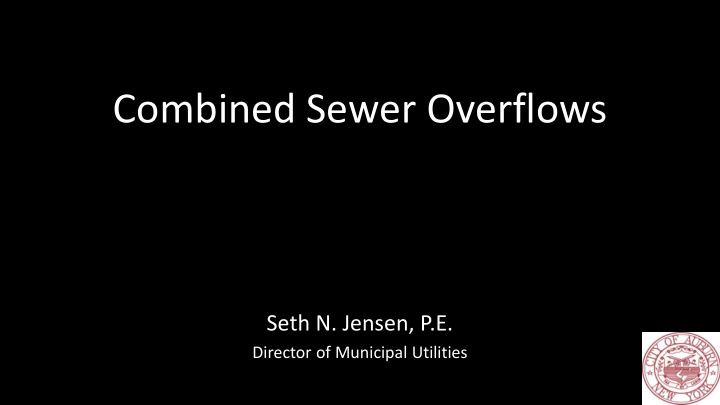



Combined Sewer Overflows Seth N. Jensen, P.E. Director of Municipal Utilities
Presentation Overview • Introduction to CSO’s • Auburn’s Sewer System Overview • Historical Overflow Events • NYALERT and Public Notification • Next Steps • Questions
What is a CSO? Combined Sewer Overflow is any discharge of sanitary sewer to a • receiving water body that results from high flows experienced during wet weather. Auburn WWTP – 40% +/- unmetered flow. • – Inflow and Infiltration (I&I) – Hydrant Testing or Water Main Breaks – Other unmetered flows – Wholesale customers, basement drains, sump pumps In the early 1990’s City of Auburn Consent Order resulted in current • sewer conveyance configuration. Auburn is a CSO community – all discharges from CSO Facilities are • permitted and monitored by NYSDEC and USEPA.
The Collection System 1000 record maps • 100+ Miles of Sanitary Sewer • in a 16 square mile City 65 miles of storm sewer • 4000-5000 MH’s and CB’s • 20 wholesale connections • and 4 towns 7.60 MGD 4 year average • flow Primarily material Clay Pipe. • 4 High rate CSO’s • 1 Storage and Release • Facility
Storage and Release Facility Basis of Design 1993 Consent Order • 6.5 Million Gallon Capacity • Activates at 3.5 MGD in • Interceptor Sewer Designed to fill during peak • flows Slowly drains as interceptor • flows decrease. Designed down stream • restriction of 3.5 mgd flow Permitted to discharge • when tank fills
High Rate Treatment x 4 Basis of Design Built per 1993 Consent • Order Designed to activate during • the 6 month storm event Swirl concentrators separate • solid material from sewer flow Observations indicate short • duration, high intensity storms cause most activations Permit max discharge • allowance per year is 4 x per CSO facility
Historical Overflow Events/Activations Year Miller Genesee Wadsworth Venice John WWTP WWTP Street Street Street Street Walsh ORF ORF Blvd. Post UV 2014 10 5 2015 15 4 2016 2 3 1 0 1 13 5 2017 2 3 0 0 3 12 5 2018 1 1 1 0 1 3 3 NYSDEC SPDES permit allows up to 4 activations for each CSO in a given year. The last column indicates the estimated ORF Activations once UV capacity is increased.
NYALERT – Full Transparency • In 2016, NYSDEC implemented NYALERT program. https://alert.ny.gov/ • City applied for $50,000 grant to develop NYALERT into current SCADA system at WWTP • Grant awarded, as of Fall 2018 – 100% Implemented • Any overflow event must be recorded within 2 hours of actual occurrence!!
Accurate and comprehensive data set. City to GPS • and integrate Sanitary and Storm System into GIS Next Steps Improve wholesale metered connections • Engineering Planning Grant – Couple current • mapping project with further engineering study including flow study to identify and prioritize I&I removal. Identify further separation projects which • incorporate state of the art storm water quality basins along the Owasco River. Further investigate and prioritize collection system • improvements and opportunities, repeat. Continue to implement BMP’s and fund Sewer • Slipline Projects keeping the separated system in good condition. Look for development opportunities and increase • capacity for future business and industry. Partner with outside towns and villages to increase • our conveyance capacity around Owasco Lake.
Questions
Recommend
More recommend